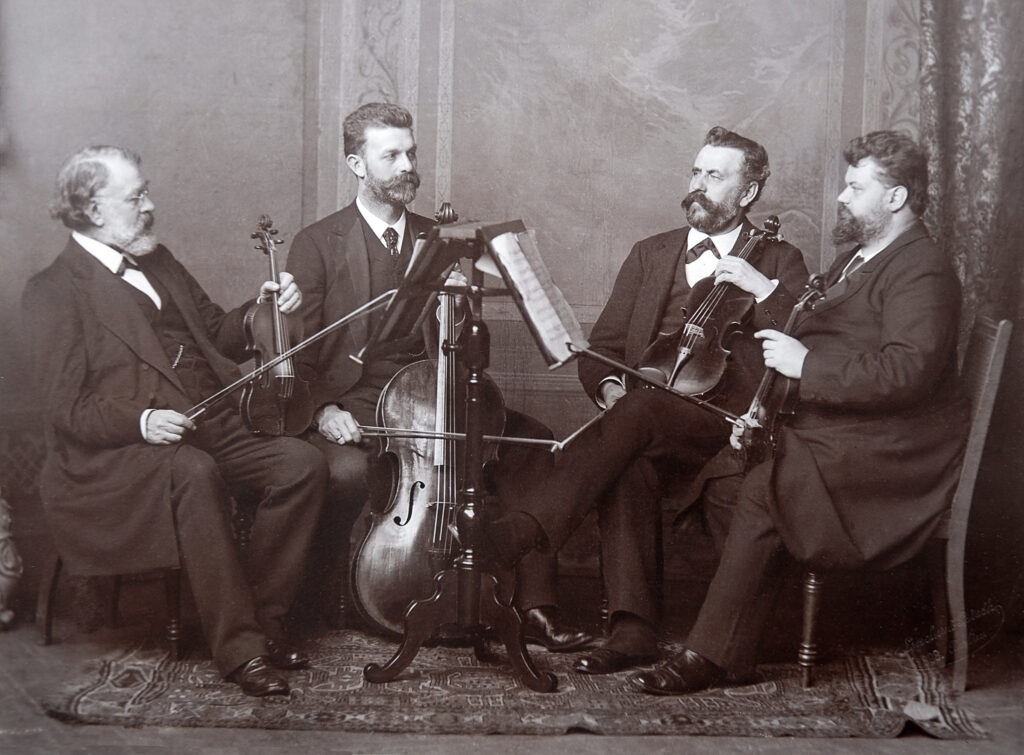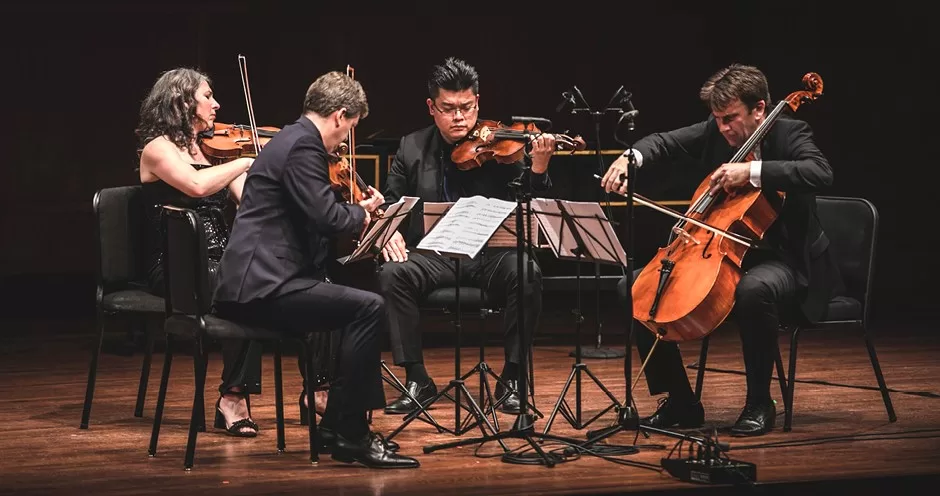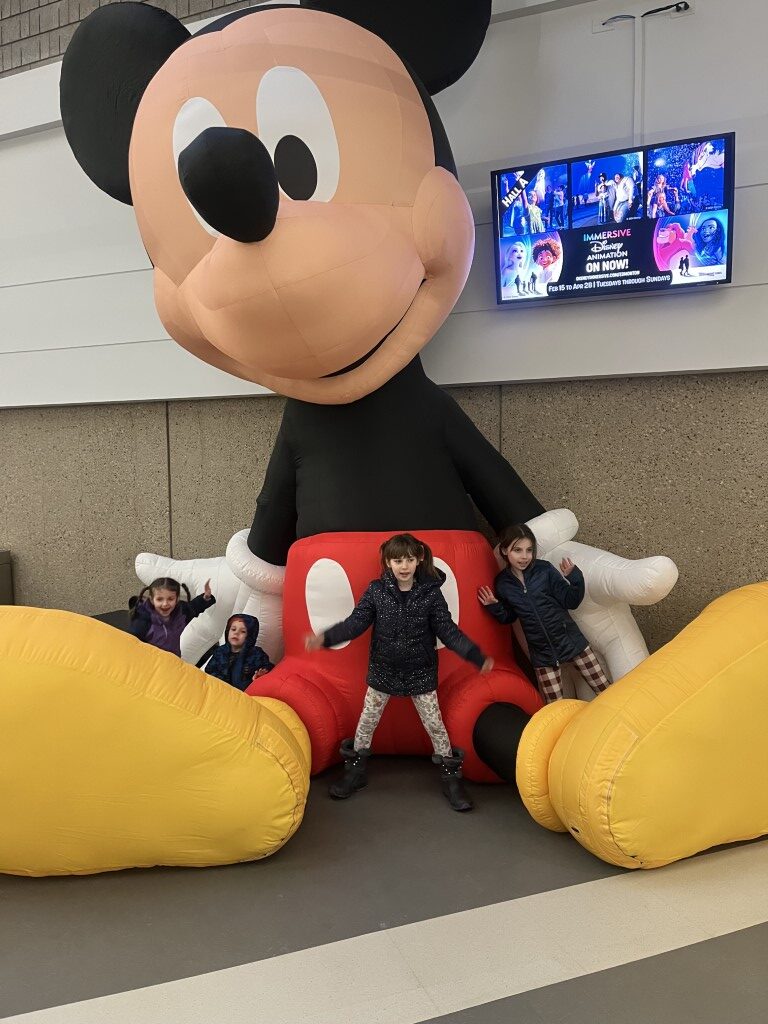Review by Mark Morris
Edmonton Chamber Music Society
Beethoven (1770-1827): String Quartet Op.18 No.6 in B-flat Major
Leoš Janáček (1854-1928): String Quartet No.2 Intimate Letters
Brahms (1833-1897): String Quartet Opus 51, No. 2, in A minor
Ehnes Quartet
James Ehnes (violin), Amy Schwartz Moretti (violin), Che-Yen Chen (viola), Edward Arron (cello)
West End Christian Reformed Church
April 23, 2025
James Ehnes, the celebrated Brandon-born violinist who now lives in Seattle, is a regular and popular visitor to Edmonton, whether as a solo artist or as the first violin of the Ehnes Quartet. The quartet was formed in Seattle in 2010, has an extensive award-winning discography, and brought a varied program to the Edmonton Recital Society’s concert on April 23 at the West End Christian Reformed Church.
It is worth saying at the outset that the venue was to the disadvantage of both the Quartet and the audience. The church is a huge box, unadorned except for rather a magnificent-looking organ, flanked by two rather enigmatic murals. The roof structure is held up by metal scaffolding that makes strange noises with any wind movement, and the thin walls all too easily allow the sirens of emergency vehicles to penetrate. The accoustics are simply awful, box-like, boomy, and cavernous, and must surely have affected the performances.
The disadvantages immediately showed in the opening work, Beethoven’s Op.18 No. 6 String Quartet in B-flat Major, where the faster, thicker-toned passages sounded muddied, notably in the Scherzo third movement. That said, this performance – especially the first two movements – was a delight. The six quartets of Op.18, written in 1801, mark the end of Beethoven’s first quartet phase, where he was shaking off the influence of Haydn, and moving towards new forms of dramatic expression.
There is, though, something of Haydn’s sense of what is proper and polite and ordered in the sixth quartet of the series – very much for four friends playing for themselves and a drawing-room audience. The Ehnes caught this sense exactly in the opening movement, a lively but never over-animated conversation among themselves – I had the image of the music accompanying a game of whist, that 19th-century precursor to bridge, and in the second slow movement one could see those characters playing their hands – lovely viola tone from Che-Yen Chen here. Beethoven called the slow introduction to the last movement ‘La Malinconia’, but in this performance that melancholy was tinged with dignified restraint.
The second work in the concert was in complete contrast to the ordered emotions of the Beethoven. Janáček’s String Quartet No.2 is subtitled ‘Intimate Letters’, because it is a musical expression of the emotions contained in the over 1,000 letters the composer wrote to Kamila Stösslová. Janáček, then aged 63, had met her in 1917 while on holiday with his wife – Stösslová was then 25, and married to an army officer, with whom she had two sons.

For last decade of his life Stösslová was his passion and his muse. They kept in close touch (Janáček and his own wife had long before agreed to live essentially separate lives), though she never attended any concert of his works. In 1928 she and her family visited Janáček at his holiday home in Hukvaldy, where Janáček caught a chill whilst searching for Stösslová’s son in the woods. Four days later he died of pneumonia with Stösslová by his side. The String Quartet No.2, composed earlier in 1928, was his last work.

And what an emotive work it is! It is Janáček’s most personal expression of the experience of love, encapsulating with passion and unerring musical logic emotions from anguish and nostalgia to longing, great beauty, and sheer intensity. Above all, there is a kind of yearning that musically seems particularly Czech. I have heard more passionate performances of this quartet – the Ehnes didn’t quite capture that yearning, for example – but if they seemed a little emotionally restrained, that may have partly been down to the acoustics of the hall. Certainly it was a fine performance to introduce those in the audience who had never heard what is one of the greatest quartets ever written. They also, intentionally or not, brought out the musical links in the opening movement – in tone, and in rhythmic and lyrical motifs – with another of Janáček’s masterpieces, the opera The Cunning Little Vixen, written from 1921 to 1923. The heroine of that opera is one of Janáček’s other great loves: Bystrouška, the cunning little vixen, whose musical character was inspired by Stösslová herself.
The second half of the concert was devoted to Brahms’ String Quartet Opus 51, No. 2, in A minor, written in 1872. Here there were distant links with the rest of the program. Brahms, always perfectionist over his chamber music, was influenced by the structural ideas and thematic development that Beethoven was exploring in the Op.18 quartets. And if Janáček’s second string quartet reflects the influence of one personalty, so does Brahms’ second. Here that personality was Brahms’ great friend the Hungarian violinist Joseph Joachim (1831-1907), whose Quartet gave the first performance of the work in 1873. Brahms uses Joachim’s musical motto (F-A-E – frei aber einsam, free but lonely) in the first movement, and then his own (F-A-F frei aber froh – free but happy) later. The first and final movement are tinged with Hungarian musical influences, another tribute to his friend.

None of this particularly matters, of course, for the purely musical qualities of the quartet suffice, but it does underline the warmth of that music. The Ehnes emphasized shared tonal qualities in rather a serious and senatorial performance, one that concentrated on tonal colour and harmony. Rather like the Janáček, this was perhaps not as idiomatic performance as it could have been – very nicely played, but not overtly characterful. Again, I wondered how much the acoustics interfered.
All that said, it was good to have the Ehnes in town, especially in a program that the audience so clearly enjoyed. James Ehnes hmself, we were told, will be back to give an Edmonton Chamber Music Society concert in September. In the meantime, the Edmonton Chamber Music Society, now celebrating their 70th anniversary, will present its annual Summer Solstice Festival from June 17 to June 22, featuring the Tesla Quartet and accordion player Michael Bridge. Details here.



